Miserly does not pay twice - we tune the memory on the AMD B450 platform and get free performance
It cannot be denied that AMD is conquering the processor market by leaps and bounds. It all started with the appearance of new products based on Zen architecture, which received the name Ryzen. Yes, the start was not as smooth as we would like, but the manufacturer made a lot of rustling. What is the secret of the success of the second generation? Why enthusiasts paid special attention not to the "top" chipset? Is it true that the network has calculator programs for memory settings? And even in games, performance will noticeably increase after tweaking? And what, there is a different memory, and some may not even earn?
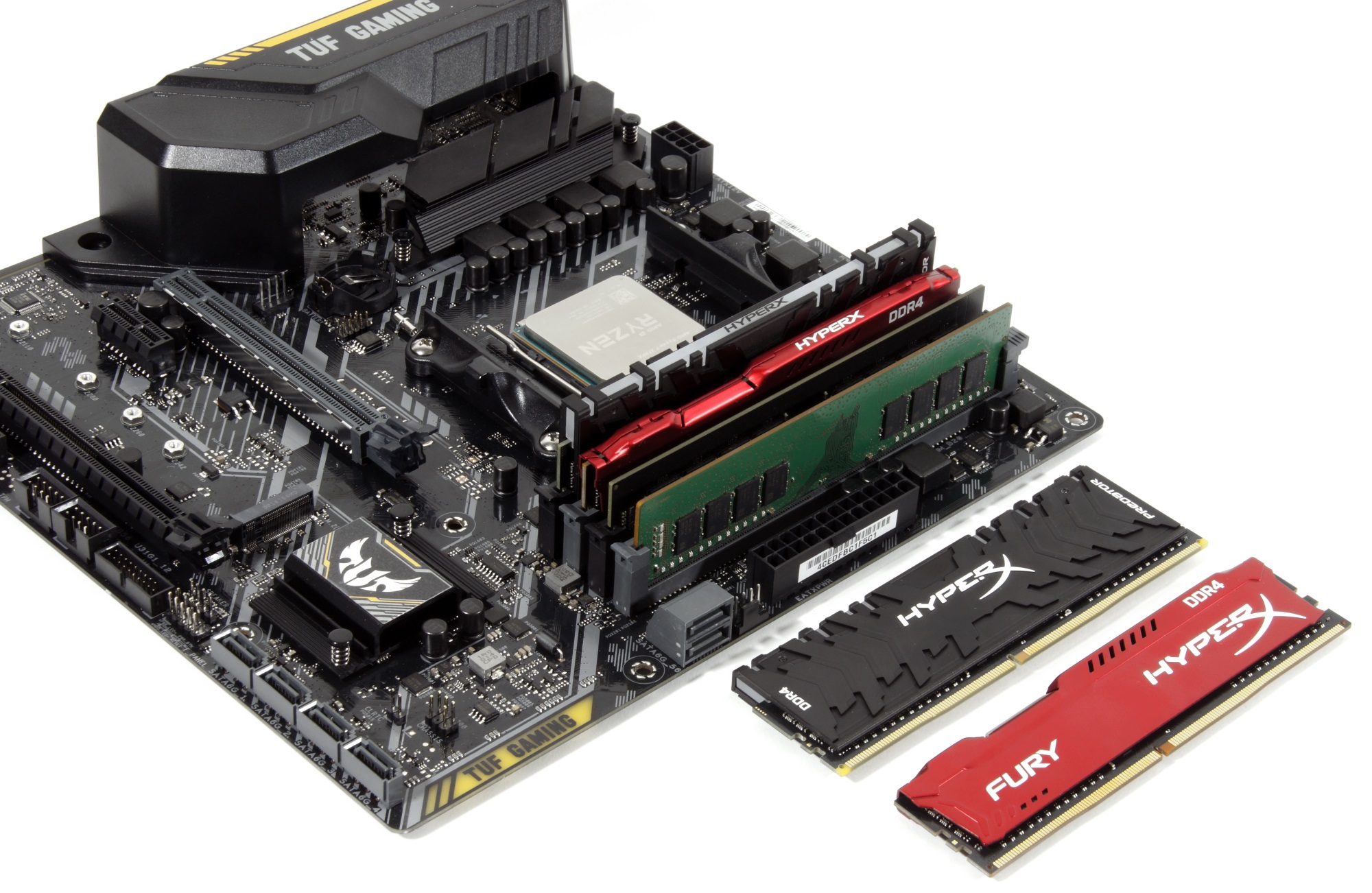
But for a start - still quite a bit of introductory information. Soon there was an update Zen +, which is just an update, not a full step of evolution. The Ryzen 2 processors began to be released on a 12 nm process technology, and the performance of working with various kinds of memory (L1, L2, L3 caches and “RAM”) increased quite well. CPU frequency control technologies such as Precision Boost 2 and XFR (Extended Frequency Range) have been improved - this has made it possible to achieve even greater performance of the processor cores. But the official support of DDR4 RAM with clock frequencies up to 2933 MHz inclusive has become especially important. Why should this be particularly emphasized? The thing is that the work of the processors Ryzen and Ryzen 2 with high-frequency RAM is one of the main problems of the platform as a whole. Of course, AMD is doing everything possible to achieve maximum compatibility with various types of memory using software updates, but for now let's describe the picture as it is. Are you used to seeing 4000+ MHz on Intel platforms? Bye - forget it. Well, let's try to find a way out of the current situation and generally understand - is it really that bad?
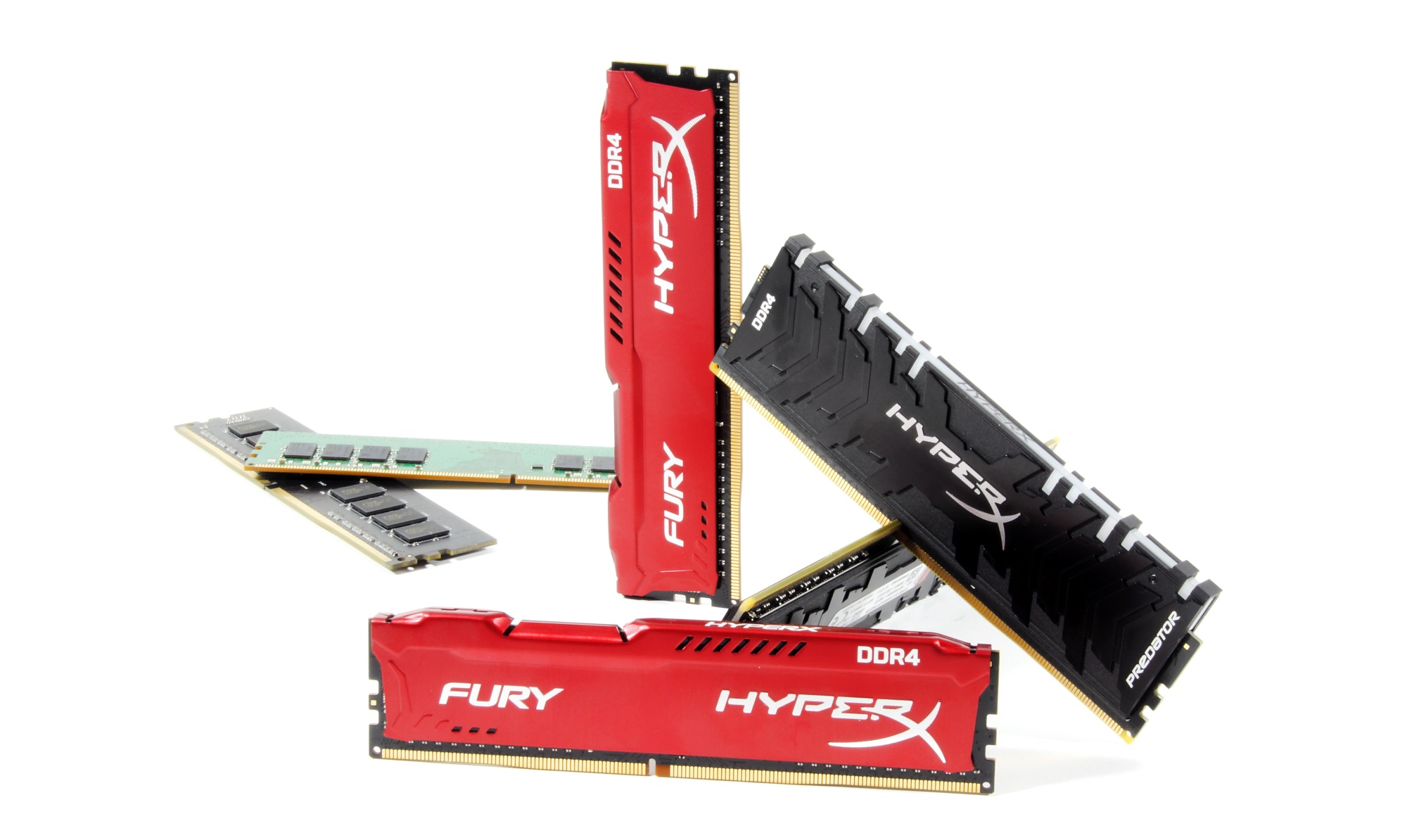
Once again, we will not load your heads with a bunch of official slides - marketing is marketing, albeit with some truth. But we will demonstrate one comparative table. It shows a comparison of two AMD chipsets of the currently actual generation - X470 and B450.

')
As you can see, although there are differences, it’s impossible to call them critical for most users. Even overclocking is supported by both options. What does it mean? True, for many, there are enough motherboards based on the B450, which was proved by motherboard sales statistics. It is the models based on the AMD B450 chipset that lead in sales in the Russian market. One of the most popular boards is the ASUS TUF B450M-Plus Gaming , which we will take as the basis for the creation of this material, as well as several game and working assemblies, which we will talk about today, but a little later.
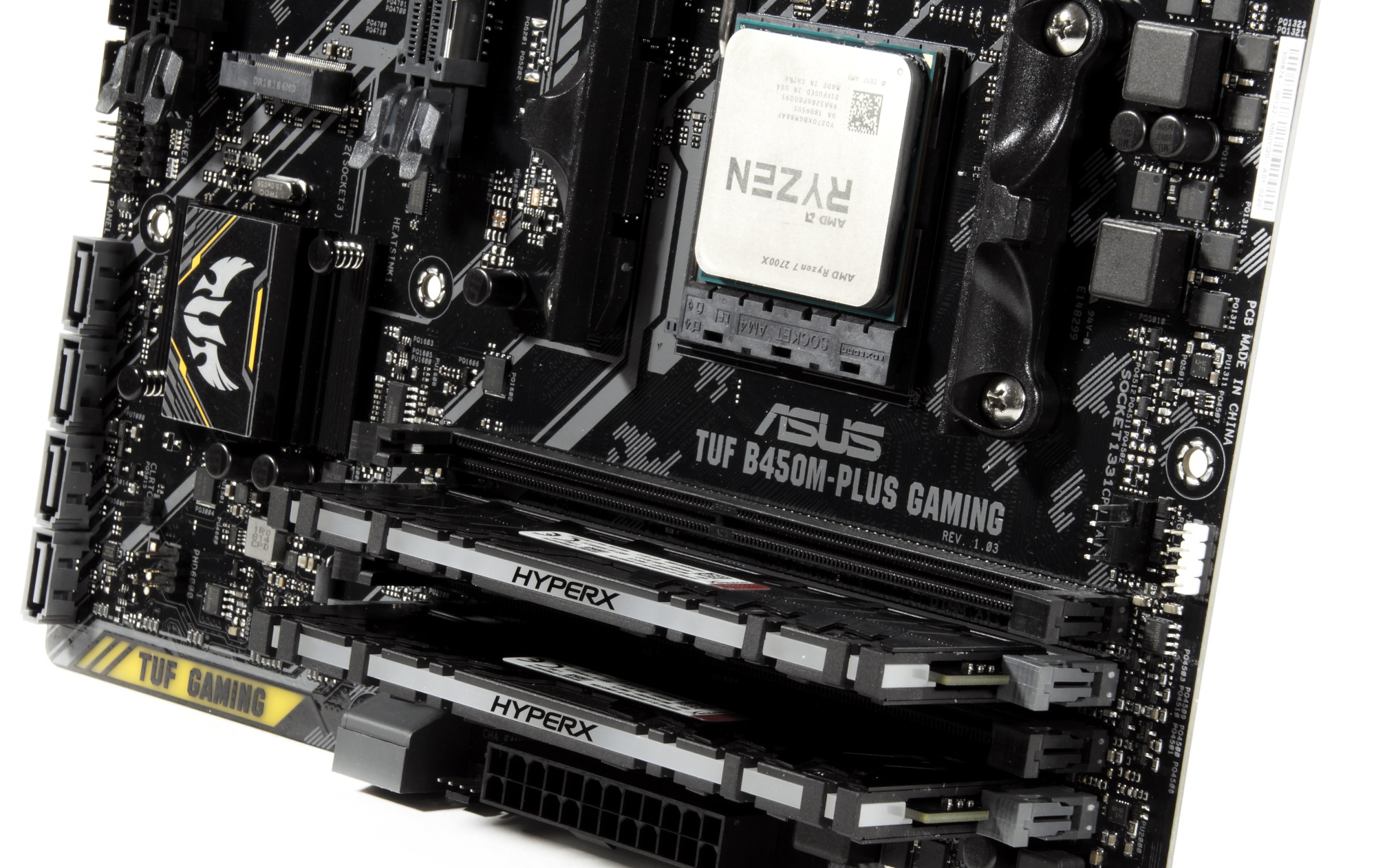
What can boards based on the B450 chipset offer? Regardless of the model and manufacturer, you get support for any Ryzen processors with the possibility of overclocking, support for all the most modern high-speed interfaces (albeit in limited quantities) and, importantly, a minimal impact on the budget.
You can choose one thing - or short, or clear. We choose the second option, but we will try to squeeze the material in order to prevent violent acts against the brain. Briefly not really happened, but it was worth it.
First, back to the issue of supporting RAM. Just take and put the high-speed modules 3866 MHz and above - will not work. Immediately another question arises - is such a fast memory needed? In the case of this platform - yes. For example, an increase in the clock frequency from 2400 MHz to 3600 MHz allows you to increase system performance by 15% or more in absolutely any task, be it games or professional programs. Much may depend on the timings, but in certain situations you can achieve a 20% increase in performance.
If you dig a story, you can see that motherboards with early BIOS versions worked very poorly with memory. It's all about AGESA - the software component of the BIOS, which is responsible for, among other things, memory initialization. Noteworthy is the fact that this part is updated along with the BIOS update in a regular way. And each update can radically change the behavior of the system. More precisely - really changes. And, to our happiness, for the better. Enthusiasts who squeeze out of their systems are ready to take any risks in order to achieve even greater performance, so they instantly “roll up the update” and publish detailed testing reports online. Ordinary users are accustomed to the phrase "work - do not touch." But this is not the case - updates really mean a lot. The only thing that can confuse some is the order of versions. Everything started well from 1.0.0.4, 1.0.0.5, and so on to 1.0.0.7, and now suddenly the numbering has changed and the current version is 0.0.7.2. So be sure to see the date of publication of the BIOS version with the update on the manufacturer's website - then you can’t go wrong
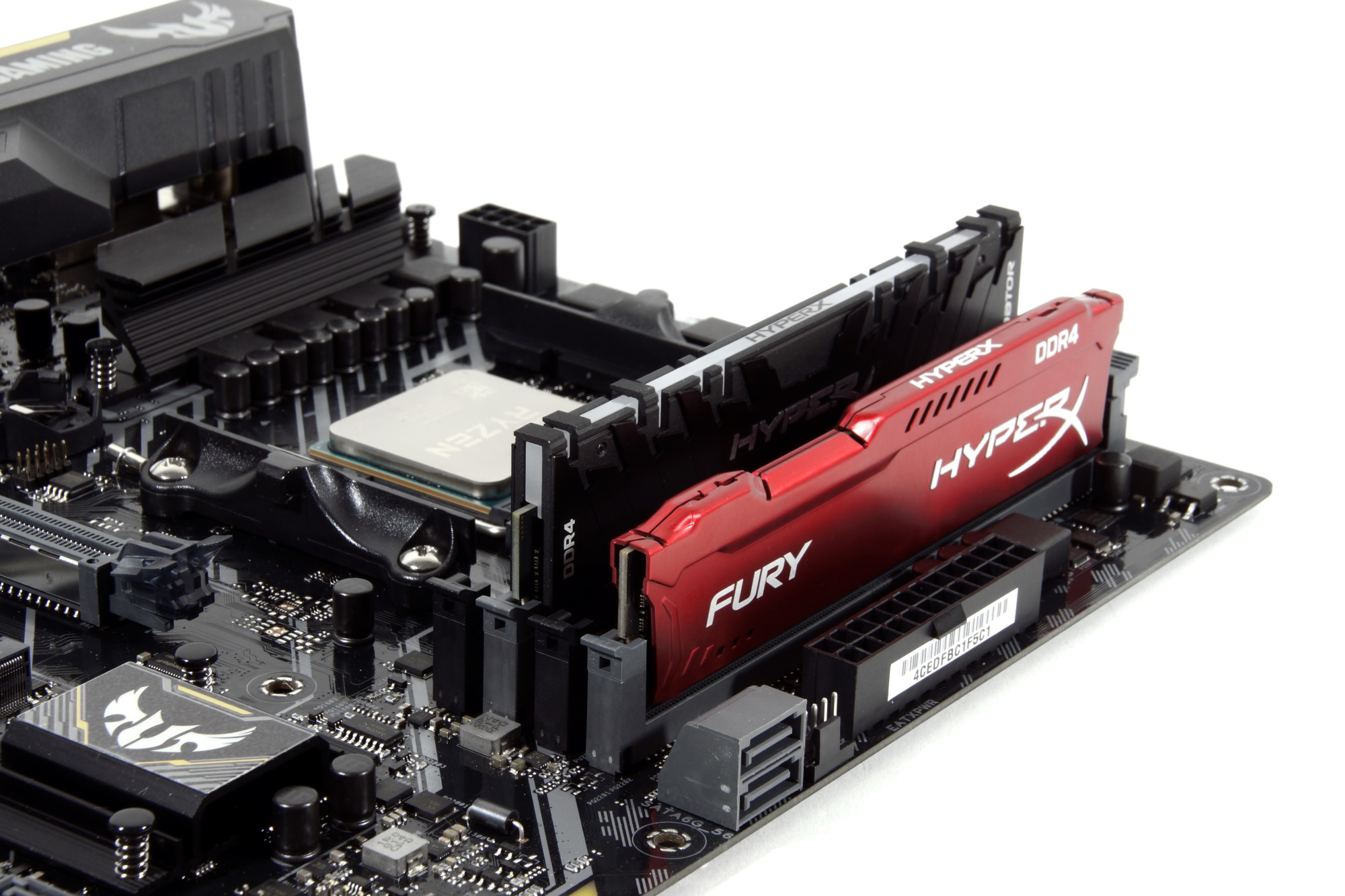
And never do as shown in the photo above - when installing memory modules from different sets, it can be quite difficult to “get” them even at the nominal frequency. Even if the system turns on in this configuration, stable performance is not guaranteed.
Now even more. If you are ready to devote some time to selecting components for your future system, then you already care about its performance up to a percent. You have already understood everything about the BIOS update, now the main thing is what kind of memory to buy? In the case of the platform we are considering today, it is strongly recommended to find peer-to-peer modules. Two-rank, of course, also fit, but are unlikely to work correctly at high clock frequencies, which are achieved by peer-to-peer modules. In fact, both types can work in pairs, but here is the will of chance. Better not to experiment. Knowing the type of a module by labeling does not always work, so you have to study the materials on the network.
Add more confusion - the information that there are memory chips A-die, B-die, C-die and others. In short, the letter means generation. Not everything new is equally useful - it’s not worth chasing the current generation of chips. For example, one of the Kingston kits that you saw in the photo today is based on Samsung B-die chips, thanks to which it was able to operate at 3,600 MHz using the above-mentioned ASUS’s TUF B450M-Plus Gaming board. Moreover, almost all Predator memory kits with or without RGB backlighting, operating at a frequency of 3,600 MHz, are based on Samsung's B-die.
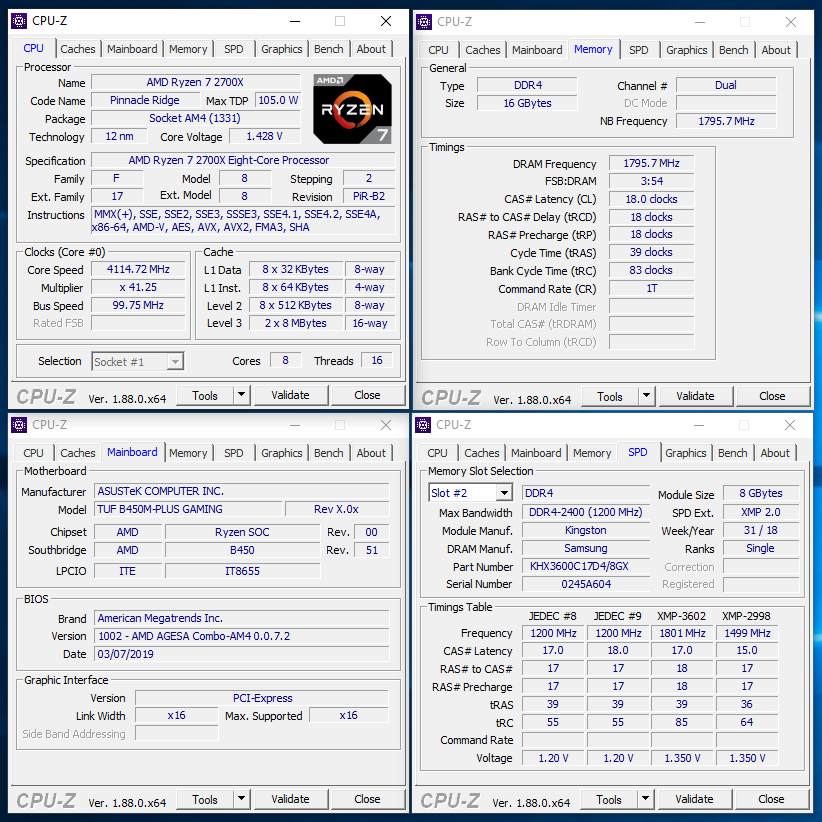
Actually, enthusiasts even complete lists of memory modules based on these chips make up - you can get acquainted on the German resource HARDWARELUXX .
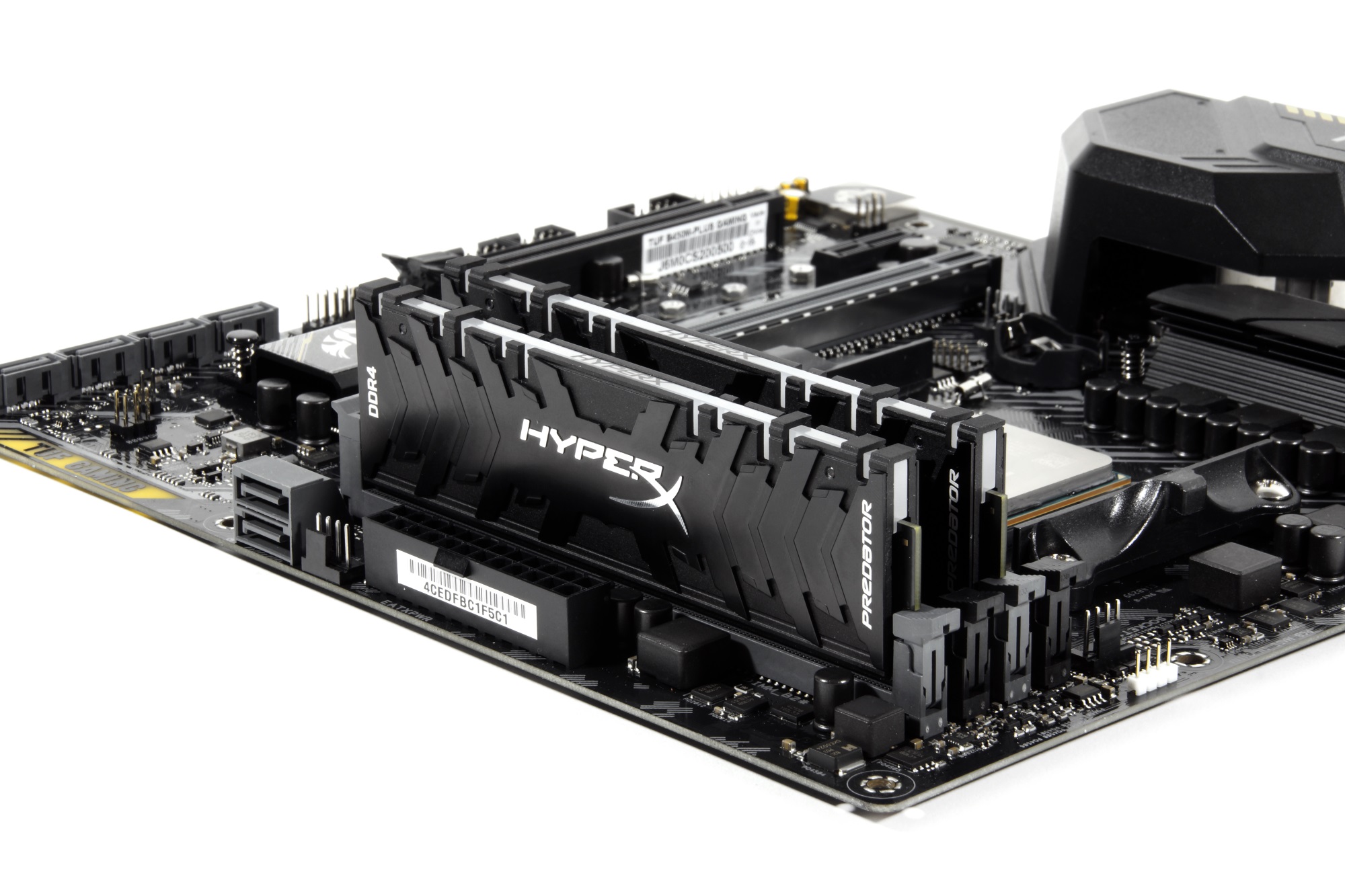
The second set, which has a frequency of 3466 MHz, which is also quite a high figure for AMD, is based on Hynix H-die chips.

If you have already bought a memory and want to find out on which chips it is based, then there are two options - information in the open spaces of the network or hope for the Thaiphoon Burner software.
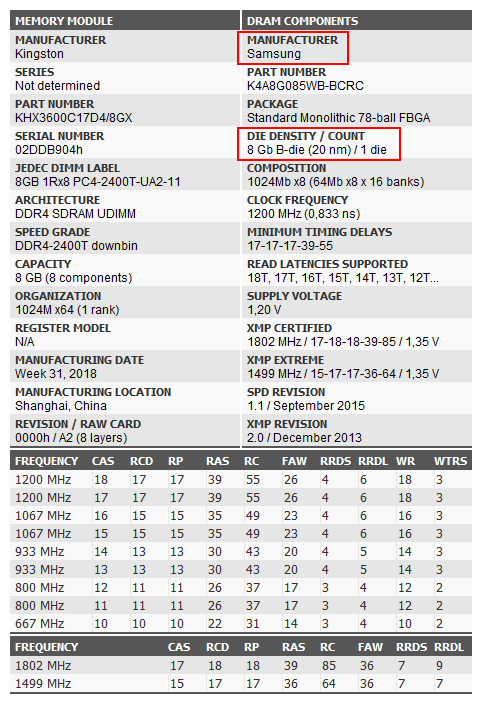
Good. We found the high-frequency memory, and it “started up” perfectly on our board. Do you think everything? An, no! Now it's time to adjust the timings. This will take a little more time than selecting the clock frequency (it is worthwhile to do this if modules with a frequency below 3000 MHz are purchased), but it will also bear fruit. You can study forums online, or you can use a special calculator program - DRAM Calculator for Ryzen. It is impossible to fully rely on the proposed settings, because each set of memory (yes, there is each module) is characterized by almost unique possibilities in terms of conquering the highest clock frequencies or reducing timings. For the most part, like overclocking any other component, this is a lottery. But a general understanding of the possibilities of memory will be. First, let the program read the data from the memory profile, then set the input data and click one of the three Calculate buttons.
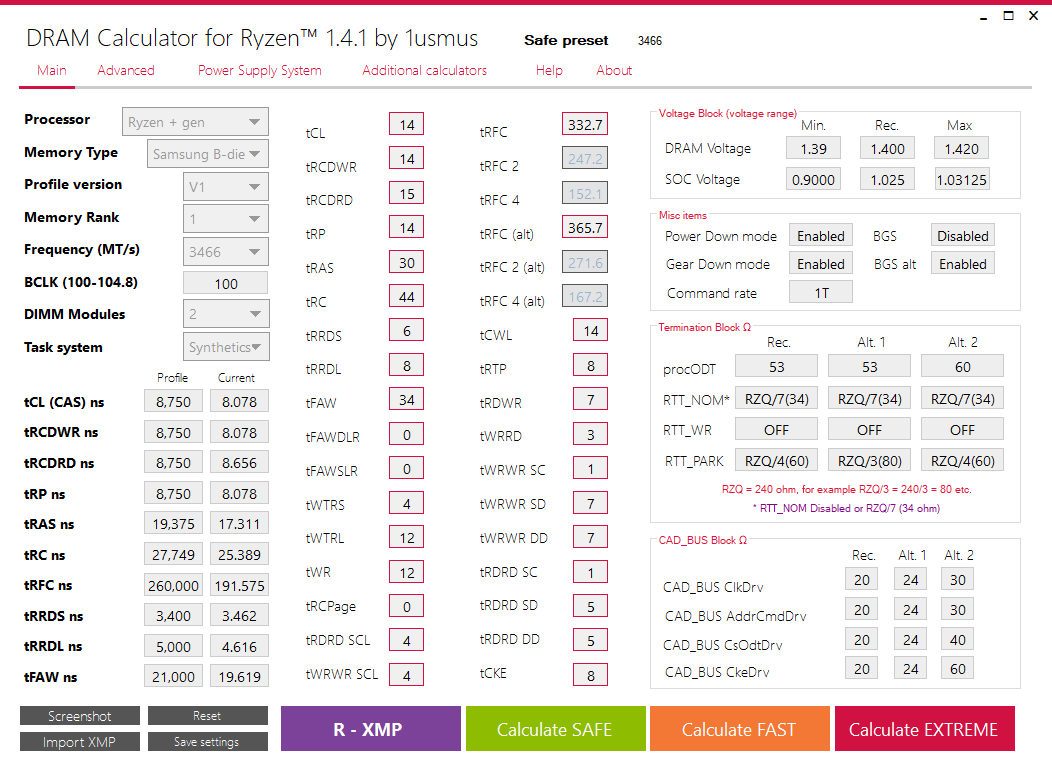
We memorize (take a screenshot, photograph, record or otherwise) the obtained data, reboot the system, enter BIOS Setup, drive in new parameters, save the whole thing and reboot the system. If we are lucky, we get a workable PC, which is strongly recommended to perform a memory stress test in order to ensure stable (or vice versa) work. If there are errors, hangs and reboots, and also if the system did not work at all after applying the settings, then we go back into the BIOS (you may have to make Clear CMOS - we study a booklet on the board how to do it) and “relax” the timings. That is, we increase them. And so on until you get a fully functional system.

Check whether your settings have been applied will help program Ryzen Timings Checker. It shows not only the main, but also all the additional ones that are involved in the configuration.
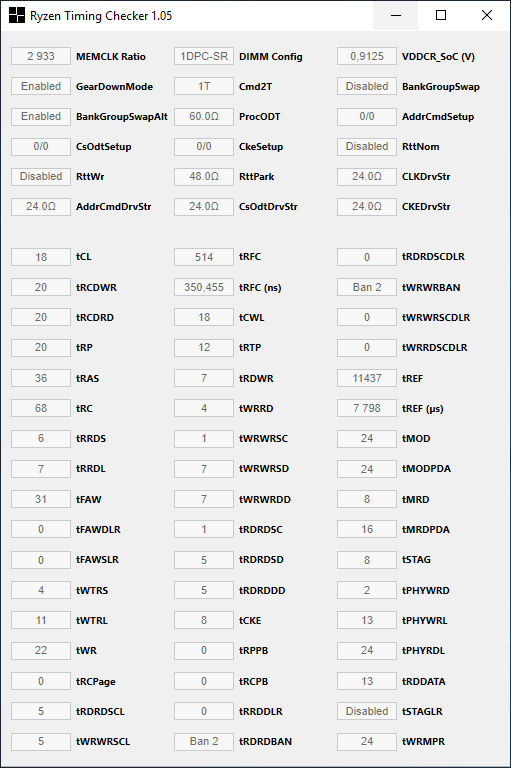
After just 30 minutes, you can grope the memory limit by timing, but the stability check will take more - you will need to test the memory with programs like MemTest (UEFI / DOS / Win) for at least 2-fold filling the entire volume. And, believe me, it is recommended to leave this testing for a longer period - at least 2-3 hours, and better all 5-6 hours. And when there are no errors found, you can begin to work on the assembled system in full. Of course, in fact, an error can manifest itself in certain scenarios - no one is immune from this, but the chance of such a situation will be much less than if you skip the testing phase and get a PC freezing or rebooting while working on your project or in games .
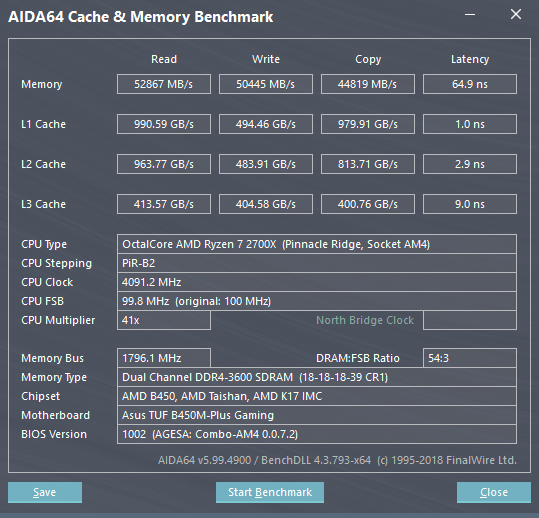
In general, if briefly, the principle of memory settings, we told. Why such torment? And judge for yourself, the results speak for themselves. Growth is everywhere, regardless of the task, whether it is an image rendering, video encoding, or any game. In games, by the way, of particular interest is the increase in the minimum performance indicator, which is an important point. The acceleration of image building or video encoding is also very noticeable, especially if you do this for several hours a day.
For a start - a little synthetics. Take the well-known AIDA64 program, a screenshot of the memory benchmark built into it. It measures the speed of reading, writing and copying data in memory, as well as the delay (access time). When reading, the increase in clock speed is noticeable immediately. Reducing timings also improves the result, although not so clearly.
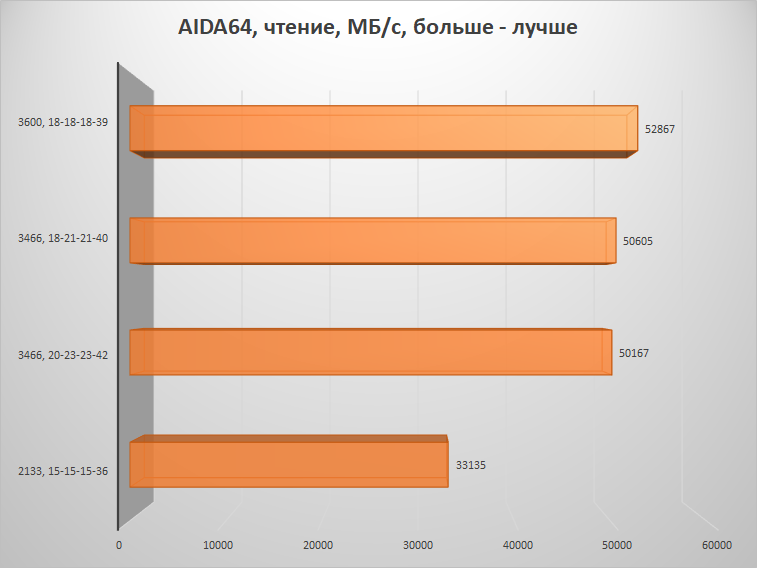
Completely similar picture when writing to memory
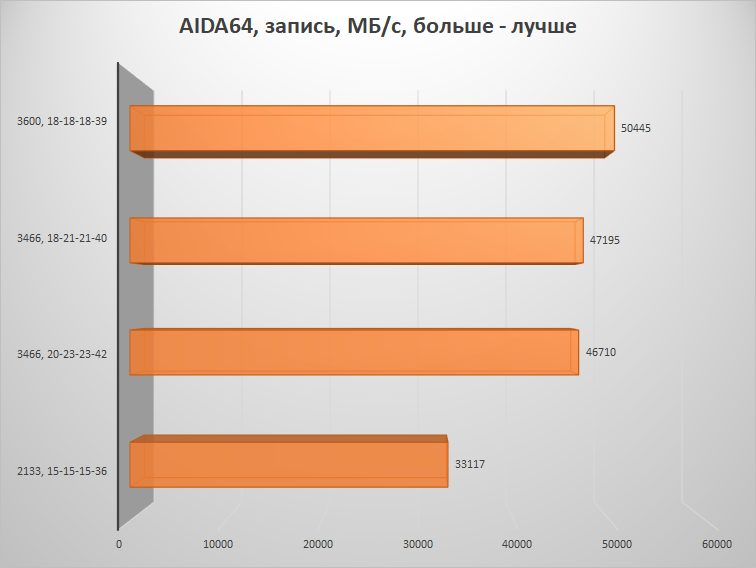
Actually, when copying data in memory, the situation does not change.
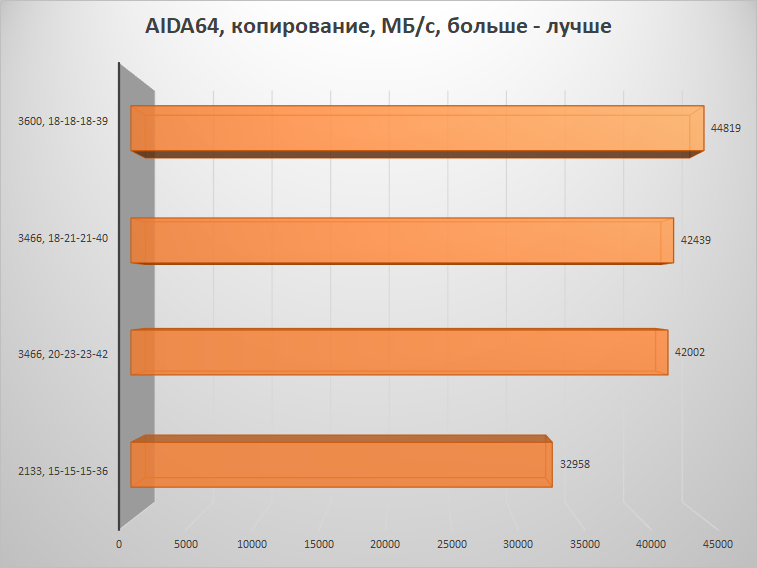
The memory access time depends on both the frequency and the timings, so the time spent on setting up these parameters is also not wasted.
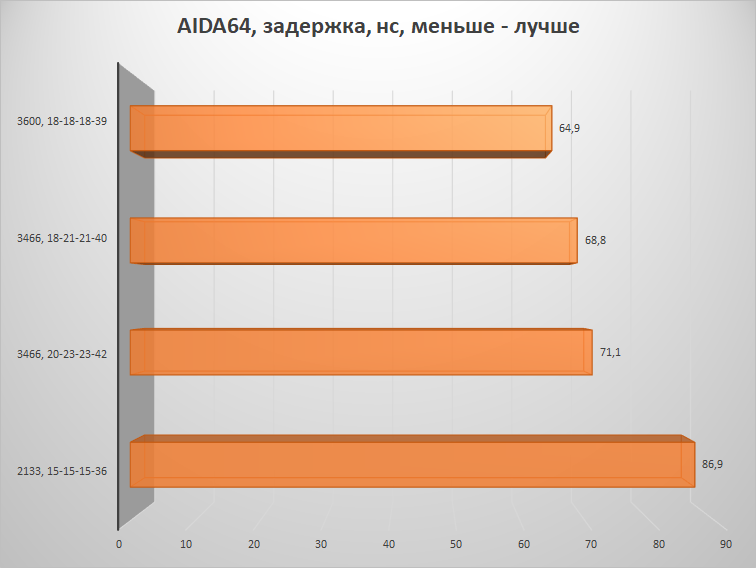
Coding a small video takes from 46 to 51 seconds. The difference of 5 seconds for a one-time action - a little. And if you process a few hours of video? 5-10 minutes from each hour of video processing is already a very significant increase!

Building a scene in Blender's 3D modeler can be done with a difference of about 40 seconds, when the total task execution time is less than 5 minutes. Simple mathematics helps us again to calculate the time saved when rendering the scene for several hours - the increase is undoubtedly noticeable!
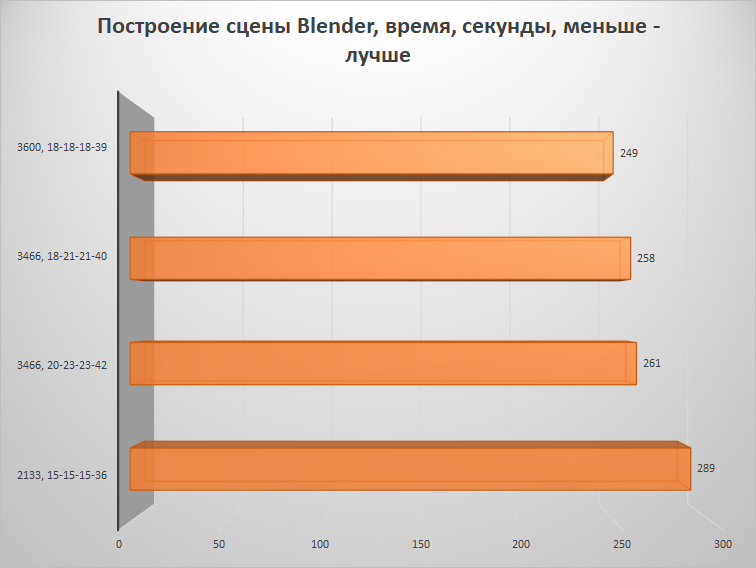
When working with another popular V-Ray rendering system, the gain is not so noticeable, but also tangible, if you build complex scenes.

Now take a few actual games. It is easy to see that with an increase in the clock frequency of the RAM, we get higher rates of frames per second. Moreover, this is true for the minimum average and even the maximum frame rate.

In the case of Far Cry 5, the minimum readings in general overstepped the accepted level of comfort - on average, over 60 frames per second were obtained.
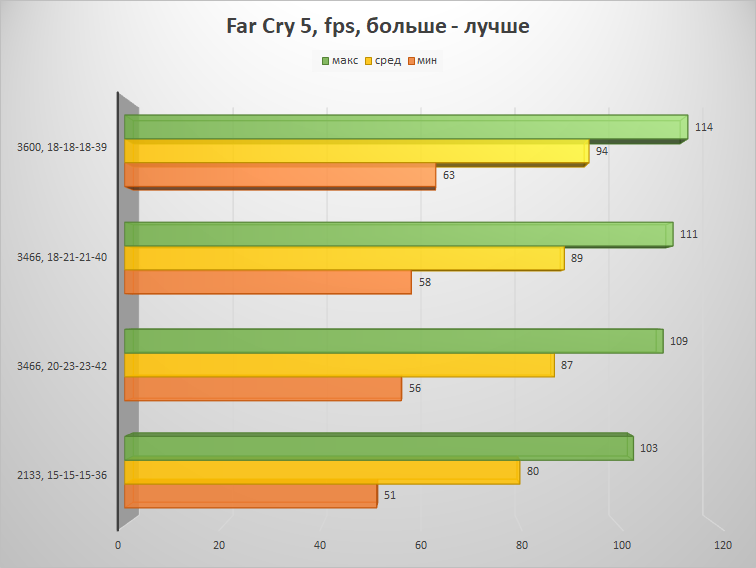
And we almost came close to this level in the game Rise of the Tomb Raider. In any case, the average has also grown quite well.

Perhaps, now you can relax a little, because the choice of RAM was the most difficult stage in the selection of components as part of the AMD-based system assembly. With processors, everything is much simpler - here you have to understand for what tasks the computer is going. But there is a limitation - only Ryzen processors. AM4 Athlon is not supported, except 200GE, 220GE and 240GE. Some attention should be paid to the disk subsystem. Here you can also divide users into two camps - one is enough SATA drives (no matter - 2.5 ”or M.2), while others will not be enough, so you should pay attention to high-speed versions with PCIE 3.0 x4 interface in the performance of connector M.2.
The best choice now are 480 GB drives, which is enough for the operating system and several games or heavy professional-level programs. In both cases, Kingston is fully capable of meeting the needs of the user - the UV500 will be economical, while the A1000 is for professionals and enthusiasts.
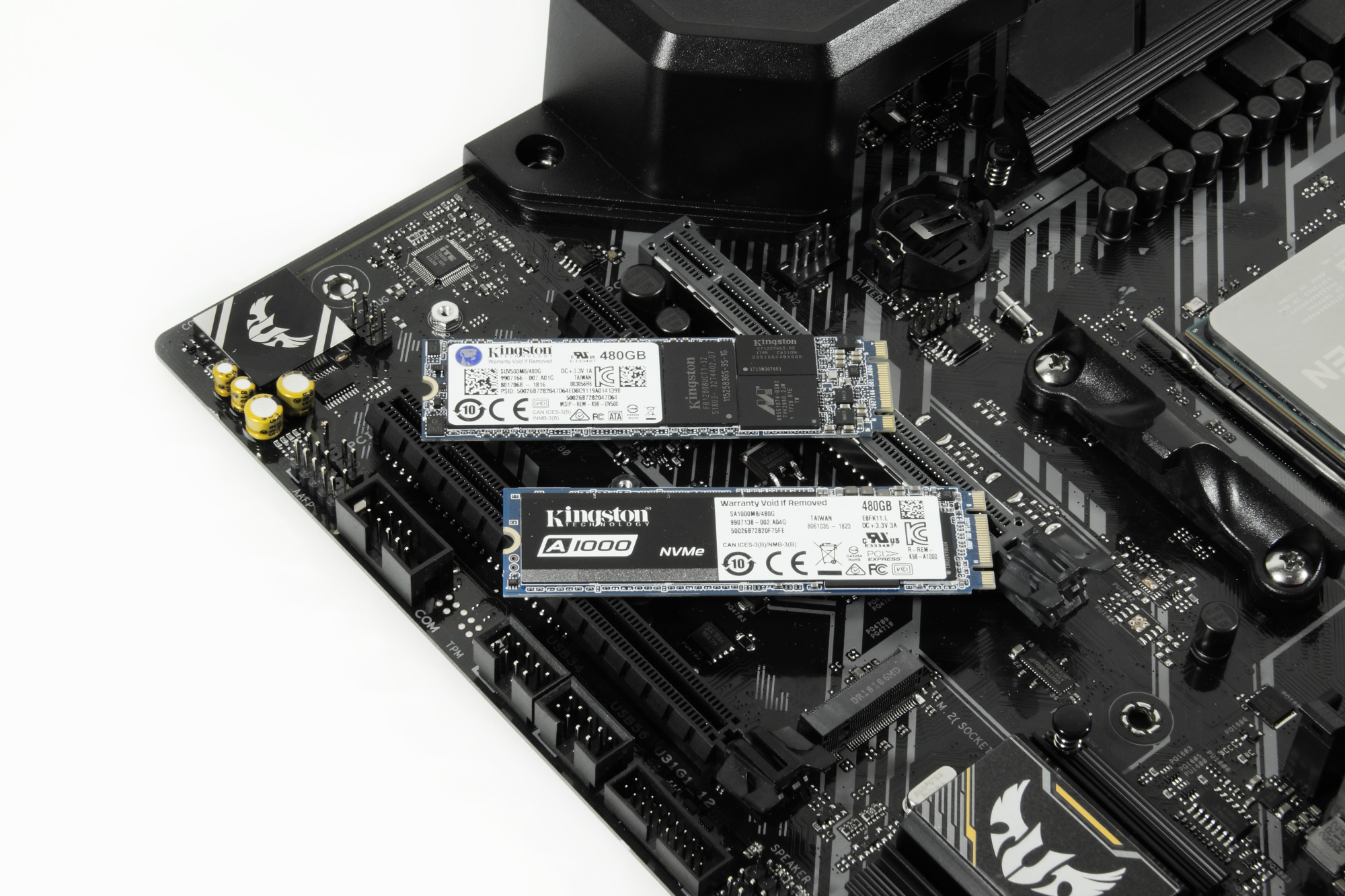
Price / performance is the criterion that is most important when building a system with a tight budget. That is why the systems based on AMD components are the most popular among economical users. With video cards, the truth is somewhat more complicated, but this is a completely different topic for conversation. Let's try to put everything on the shelves, taking as a basis the motherboard with the B450 chipset and supplementing it with a body kit of a different caliber.
The minimum for games is an assembly with a Ryzen 3 2300X processor and a discrete video card of the RTX 2060 level. Although, the video card is to the taste, or rather, according to its capabilities. As we have seen today, memory is by far not the last place in importance, therefore HyperX Fury HX434C19FR2K2 / 16 (16 GB with a frequency of 3466 MHz) will suit you just right here. As the main drive, we can safely recommend the UV500 with a capacity of 480 GB, which was mentioned above. Everything is simple - the price tag is adequate, the speed is at the limit for the interface level, there is enough space for all the most basic, including several even the most capacious games. If you add to this a high-quality power supply, an efficient cooling system, a good body and a 3.5 ”disk for storing data, then you can meet the sum of 40,000 rubles without taking into account the video card. For example, if you look at the RTX 2060, then it’s still about 22,000 rubles on top. For clarity, we present this data in the form of a table. Immediately, we note that for this and two other assembly options, we chose components of exclusively reputable brands, such as Corsair, be quiet !, CoolerMaster, Western Digital, and others. There is no cheap "nouneyma" that can lead to system failure (a hint of power supplies). That is why prices are not the lowest, but no risk.
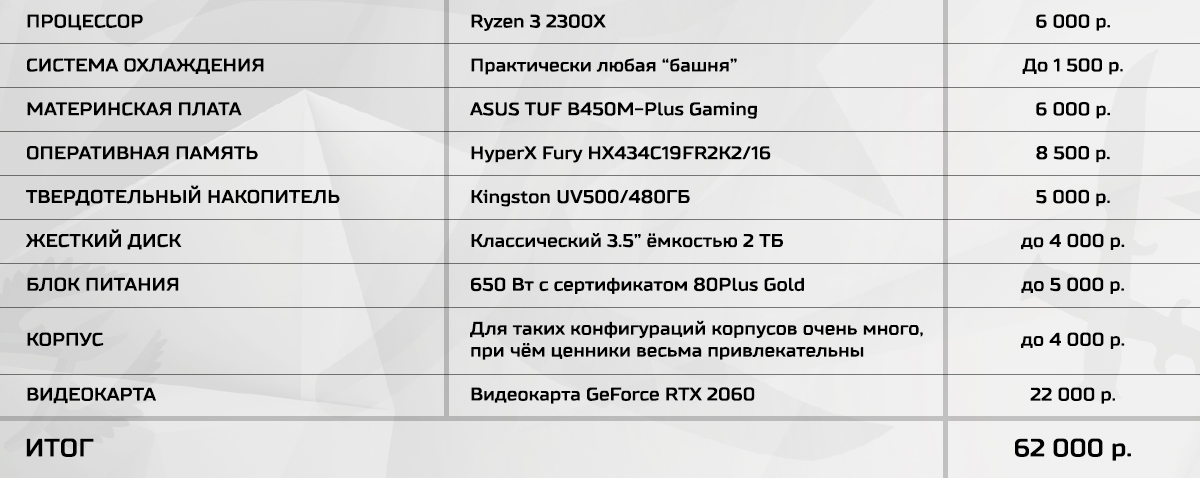
Play and work - the board is unchanged, but already with the Ryzen 5 2600X. When using similar components, such an assembly (again without a video card) will cost approximately 45,000 rubles. What can be improved? For example, install more efficient memory, such as the HyperX Predator HX436C17PB3AK2 / 16 - the same amount (16 GB), but with a frequency of 3600 MHz. The above price includes a more powerful power supply, the case is more spacious, and the cooling system for the processor is more efficient. Taking into account the replacement of memory, as well as the drive on the Kingston A1000 with a capacity of 480 GB (but already much faster), the price tag will rise to the level of about 48,000 rubles, if you choose the most attractive offers. In the table, we will indicate prices with a certain margin, taking average or about retail prices, so the result is somewhat higher than what has just been announced. But in 48000-50000 rubles, you can easily meet the order, if you order components for the best deals in different outlets. For the video card will have to pay an additional amount. If this will be, for example, RTX 2070, reserve about 35,000 rubles on top
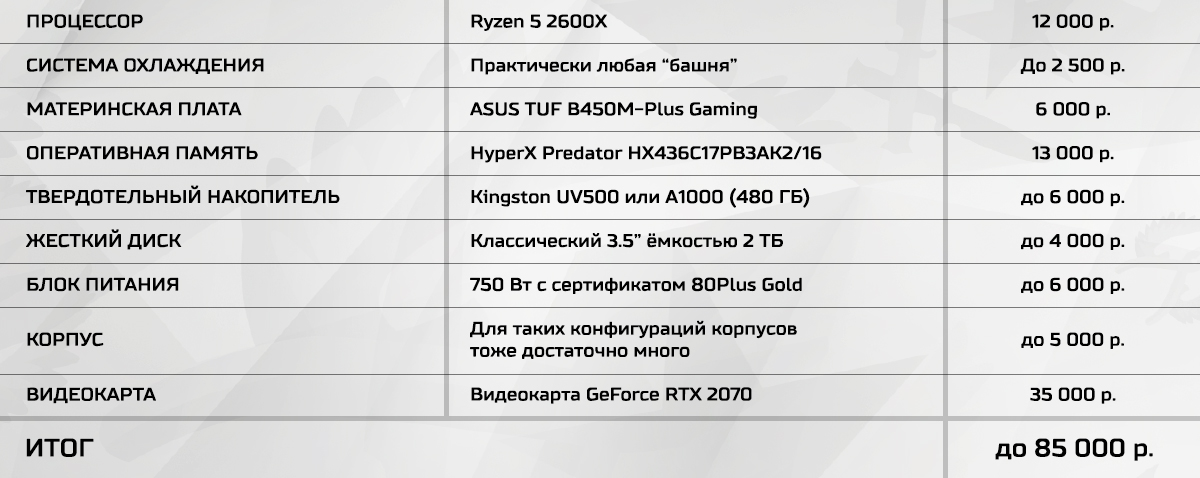
For any tasks within reason - again, the board is based on AMD B450, but we take the most productive processor - Ryzen 7 2700X. Since we want to get maximum performance, but without losing your mind in terms of the amount spent, the memory selection will remain unchanged (HyperX Predator 3600 MHz), the drive is already Kingston A1000 (use SATA solution in such an assembly is sacrilege) and the cooling system allocated even larger amounts, but within reason. This configuration is already at 68,000 rubles, but again - without a video card. There’s really no choice - RTX 2080 or RTX 2080 Ti, which, accordingly, deprives us of 47,000 or 73,000 rubles, respectively.
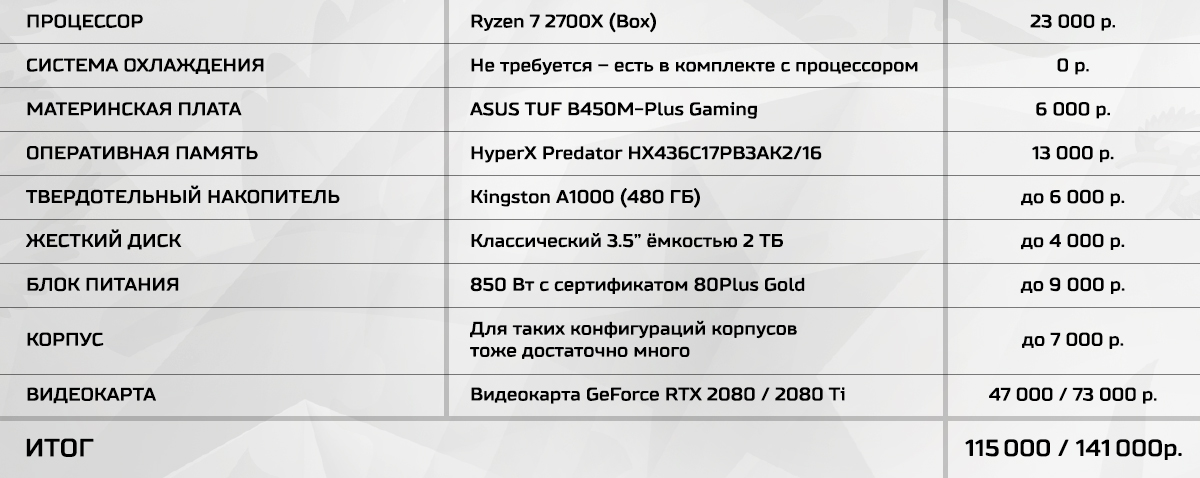
What is remarkable about any of these assemblies? An inexpensive motherboard is not on the most advanced chipset, which allows you to organize a gaming or working system with one video card, one high-performance solid-state drive and very fast RAM.
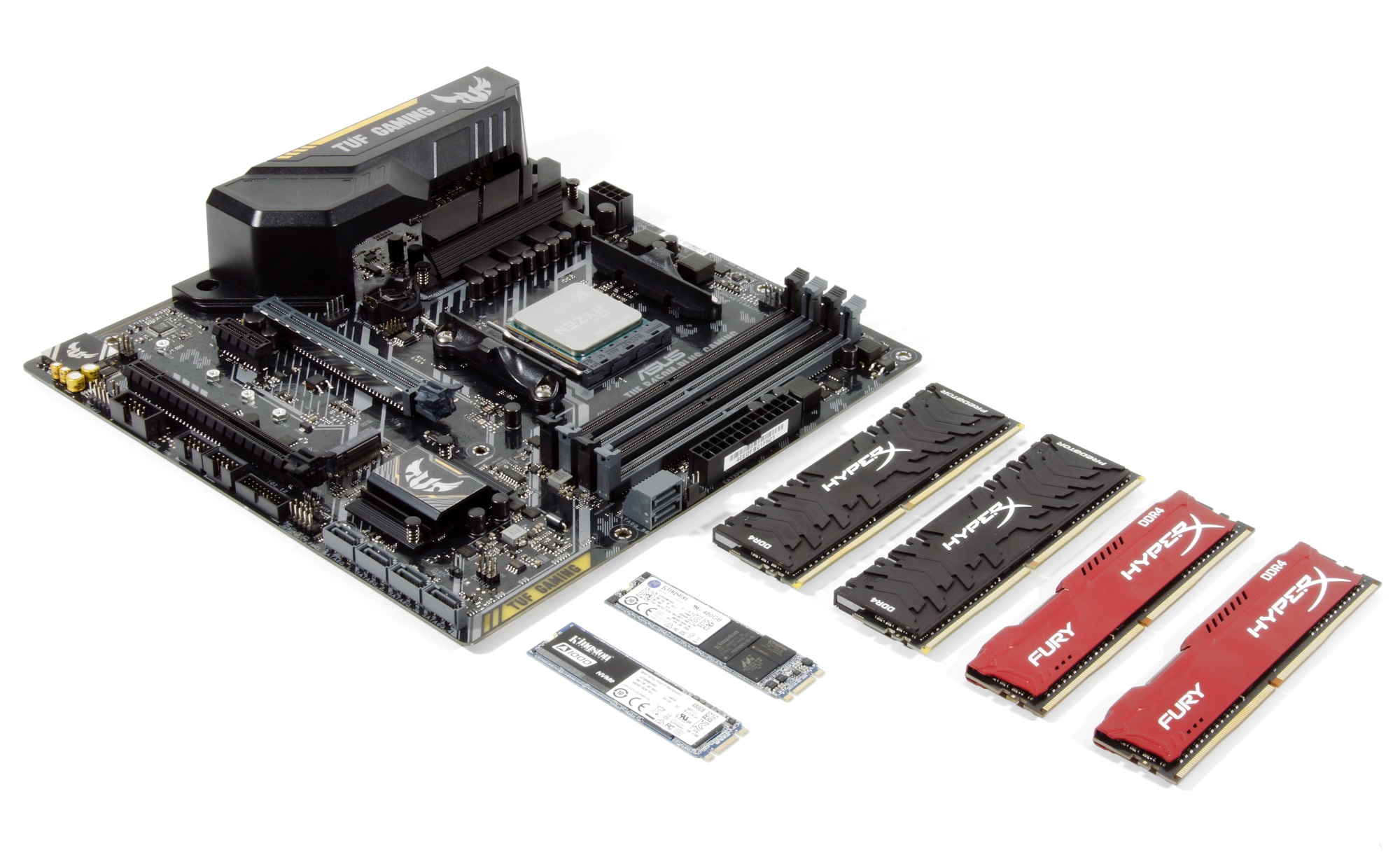
It seems that we have answered all the questions posed in this material. At least, if advanced enthusiasts haven’t learned anything new, many simple users are now up to date - the choice of RAM for the AMD platform is an extremely important step in the selection of components, on which system performance in any tasks can strongly depend. In part, we have even simplified your task by pointing out the high-frequency memory modules HyperX Fury and HyperX Predator, which were the main figures in the case and function without any problems on the far most expensive motherboard. It should be separately noted that this is indeed the achievement of Kingston engineers - a rich set of built-in settings profiles ensured that the system was correctly turned on the first time, with full stability at the stated clock frequencies. As for motherboards, the situation here is somewhat simpler than if you look in the direction of Intel, whose memory overclocking above 2666 MHz is available only on Z-series chipsets, solutions based on which are more expensive, not to mention the cost of the processor itself. It is gratifying to see that AMD has unleashed a serious war for the processor market, where we remain the only winners, because healthy competition is the best way to develop technologies. Are you ready to spend a few extra days studying the materials in the network and selecting the settings on the purchased system to save a significant amount of money? Now, we hope so!
HyperX Fury DDR4 and HyperX Predator DDR4 high-speed memory modules can be found in the CSO stores ! and Onlinetrade.ru .
High-speed memory Fury can be found in the store OLDI .
For more information about HyperX and Kingston products, please visit the company websites.

But for a start - still quite a bit of introductory information. Soon there was an update Zen +, which is just an update, not a full step of evolution. The Ryzen 2 processors began to be released on a 12 nm process technology, and the performance of working with various kinds of memory (L1, L2, L3 caches and “RAM”) increased quite well. CPU frequency control technologies such as Precision Boost 2 and XFR (Extended Frequency Range) have been improved - this has made it possible to achieve even greater performance of the processor cores. But the official support of DDR4 RAM with clock frequencies up to 2933 MHz inclusive has become especially important. Why should this be particularly emphasized? The thing is that the work of the processors Ryzen and Ryzen 2 with high-frequency RAM is one of the main problems of the platform as a whole. Of course, AMD is doing everything possible to achieve maximum compatibility with various types of memory using software updates, but for now let's describe the picture as it is. Are you used to seeing 4000+ MHz on Intel platforms? Bye - forget it. Well, let's try to find a way out of the current situation and generally understand - is it really that bad?

What is the secret to the success of B450 motherboards?
Once again, we will not load your heads with a bunch of official slides - marketing is marketing, albeit with some truth. But we will demonstrate one comparative table. It shows a comparison of two AMD chipsets of the currently actual generation - X470 and B450.

')
As you can see, although there are differences, it’s impossible to call them critical for most users. Even overclocking is supported by both options. What does it mean? True, for many, there are enough motherboards based on the B450, which was proved by motherboard sales statistics. It is the models based on the AMD B450 chipset that lead in sales in the Russian market. One of the most popular boards is the ASUS TUF B450M-Plus Gaming , which we will take as the basis for the creation of this material, as well as several game and working assemblies, which we will talk about today, but a little later.

What can boards based on the B450 chipset offer? Regardless of the model and manufacturer, you get support for any Ryzen processors with the possibility of overclocking, support for all the most modern high-speed interfaces (albeit in limited quantities) and, importantly, a minimal impact on the budget.
Can be explained shortly and clearly?
You can choose one thing - or short, or clear. We choose the second option, but we will try to squeeze the material in order to prevent violent acts against the brain. Briefly not really happened, but it was worth it.
First, back to the issue of supporting RAM. Just take and put the high-speed modules 3866 MHz and above - will not work. Immediately another question arises - is such a fast memory needed? In the case of this platform - yes. For example, an increase in the clock frequency from 2400 MHz to 3600 MHz allows you to increase system performance by 15% or more in absolutely any task, be it games or professional programs. Much may depend on the timings, but in certain situations you can achieve a 20% increase in performance.
If you dig a story, you can see that motherboards with early BIOS versions worked very poorly with memory. It's all about AGESA - the software component of the BIOS, which is responsible for, among other things, memory initialization. Noteworthy is the fact that this part is updated along with the BIOS update in a regular way. And each update can radically change the behavior of the system. More precisely - really changes. And, to our happiness, for the better. Enthusiasts who squeeze out of their systems are ready to take any risks in order to achieve even greater performance, so they instantly “roll up the update” and publish detailed testing reports online. Ordinary users are accustomed to the phrase "work - do not touch." But this is not the case - updates really mean a lot. The only thing that can confuse some is the order of versions. Everything started well from 1.0.0.4, 1.0.0.5, and so on to 1.0.0.7, and now suddenly the numbering has changed and the current version is 0.0.7.2. So be sure to see the date of publication of the BIOS version with the update on the manufacturer's website - then you can’t go wrong

And never do as shown in the photo above - when installing memory modules from different sets, it can be quite difficult to “get” them even at the nominal frequency. Even if the system turns on in this configuration, stable performance is not guaranteed.
Now even more. If you are ready to devote some time to selecting components for your future system, then you already care about its performance up to a percent. You have already understood everything about the BIOS update, now the main thing is what kind of memory to buy? In the case of the platform we are considering today, it is strongly recommended to find peer-to-peer modules. Two-rank, of course, also fit, but are unlikely to work correctly at high clock frequencies, which are achieved by peer-to-peer modules. In fact, both types can work in pairs, but here is the will of chance. Better not to experiment. Knowing the type of a module by labeling does not always work, so you have to study the materials on the network.
Add more confusion - the information that there are memory chips A-die, B-die, C-die and others. In short, the letter means generation. Not everything new is equally useful - it’s not worth chasing the current generation of chips. For example, one of the Kingston kits that you saw in the photo today is based on Samsung B-die chips, thanks to which it was able to operate at 3,600 MHz using the above-mentioned ASUS’s TUF B450M-Plus Gaming board. Moreover, almost all Predator memory kits with or without RGB backlighting, operating at a frequency of 3,600 MHz, are based on Samsung's B-die.

Actually, enthusiasts even complete lists of memory modules based on these chips make up - you can get acquainted on the German resource HARDWARELUXX .

The second set, which has a frequency of 3466 MHz, which is also quite a high figure for AMD, is based on Hynix H-die chips.

If you have already bought a memory and want to find out on which chips it is based, then there are two options - information in the open spaces of the network or hope for the Thaiphoon Burner software.

Good. We found the high-frequency memory, and it “started up” perfectly on our board. Do you think everything? An, no! Now it's time to adjust the timings. This will take a little more time than selecting the clock frequency (it is worthwhile to do this if modules with a frequency below 3000 MHz are purchased), but it will also bear fruit. You can study forums online, or you can use a special calculator program - DRAM Calculator for Ryzen. It is impossible to fully rely on the proposed settings, because each set of memory (yes, there is each module) is characterized by almost unique possibilities in terms of conquering the highest clock frequencies or reducing timings. For the most part, like overclocking any other component, this is a lottery. But a general understanding of the possibilities of memory will be. First, let the program read the data from the memory profile, then set the input data and click one of the three Calculate buttons.

We memorize (take a screenshot, photograph, record or otherwise) the obtained data, reboot the system, enter BIOS Setup, drive in new parameters, save the whole thing and reboot the system. If we are lucky, we get a workable PC, which is strongly recommended to perform a memory stress test in order to ensure stable (or vice versa) work. If there are errors, hangs and reboots, and also if the system did not work at all after applying the settings, then we go back into the BIOS (you may have to make Clear CMOS - we study a booklet on the board how to do it) and “relax” the timings. That is, we increase them. And so on until you get a fully functional system.

Check whether your settings have been applied will help program Ryzen Timings Checker. It shows not only the main, but also all the additional ones that are involved in the configuration.

After just 30 minutes, you can grope the memory limit by timing, but the stability check will take more - you will need to test the memory with programs like MemTest (UEFI / DOS / Win) for at least 2-fold filling the entire volume. And, believe me, it is recommended to leave this testing for a longer period - at least 2-3 hours, and better all 5-6 hours. And when there are no errors found, you can begin to work on the assembled system in full. Of course, in fact, an error can manifest itself in certain scenarios - no one is immune from this, but the chance of such a situation will be much less than if you skip the testing phase and get a PC freezing or rebooting while working on your project or in games .

In general, if briefly, the principle of memory settings, we told. Why such torment? And judge for yourself, the results speak for themselves. Growth is everywhere, regardless of the task, whether it is an image rendering, video encoding, or any game. In games, by the way, of particular interest is the increase in the minimum performance indicator, which is an important point. The acceleration of image building or video encoding is also very noticeable, especially if you do this for several hours a day.
For a start - a little synthetics. Take the well-known AIDA64 program, a screenshot of the memory benchmark built into it. It measures the speed of reading, writing and copying data in memory, as well as the delay (access time). When reading, the increase in clock speed is noticeable immediately. Reducing timings also improves the result, although not so clearly.

Completely similar picture when writing to memory

Actually, when copying data in memory, the situation does not change.

The memory access time depends on both the frequency and the timings, so the time spent on setting up these parameters is also not wasted.

Coding a small video takes from 46 to 51 seconds. The difference of 5 seconds for a one-time action - a little. And if you process a few hours of video? 5-10 minutes from each hour of video processing is already a very significant increase!

Building a scene in Blender's 3D modeler can be done with a difference of about 40 seconds, when the total task execution time is less than 5 minutes. Simple mathematics helps us again to calculate the time saved when rendering the scene for several hours - the increase is undoubtedly noticeable!

When working with another popular V-Ray rendering system, the gain is not so noticeable, but also tangible, if you build complex scenes.

Now take a few actual games. It is easy to see that with an increase in the clock frequency of the RAM, we get higher rates of frames per second. Moreover, this is true for the minimum average and even the maximum frame rate.

In the case of Far Cry 5, the minimum readings in general overstepped the accepted level of comfort - on average, over 60 frames per second were obtained.

And we almost came close to this level in the game Rise of the Tomb Raider. In any case, the average has also grown quite well.

The hardest thing behind
Perhaps, now you can relax a little, because the choice of RAM was the most difficult stage in the selection of components as part of the AMD-based system assembly. With processors, everything is much simpler - here you have to understand for what tasks the computer is going. But there is a limitation - only Ryzen processors. AM4 Athlon is not supported, except 200GE, 220GE and 240GE. Some attention should be paid to the disk subsystem. Here you can also divide users into two camps - one is enough SATA drives (no matter - 2.5 ”or M.2), while others will not be enough, so you should pay attention to high-speed versions with PCIE 3.0 x4 interface in the performance of connector M.2.
The best choice now are 480 GB drives, which is enough for the operating system and several games or heavy professional-level programs. In both cases, Kingston is fully capable of meeting the needs of the user - the UV500 will be economical, while the A1000 is for professionals and enthusiasts.

When money does not pocket tight
Price / performance is the criterion that is most important when building a system with a tight budget. That is why the systems based on AMD components are the most popular among economical users. With video cards, the truth is somewhat more complicated, but this is a completely different topic for conversation. Let's try to put everything on the shelves, taking as a basis the motherboard with the B450 chipset and supplementing it with a body kit of a different caliber.
The minimum for games is an assembly with a Ryzen 3 2300X processor and a discrete video card of the RTX 2060 level. Although, the video card is to the taste, or rather, according to its capabilities. As we have seen today, memory is by far not the last place in importance, therefore HyperX Fury HX434C19FR2K2 / 16 (16 GB with a frequency of 3466 MHz) will suit you just right here. As the main drive, we can safely recommend the UV500 with a capacity of 480 GB, which was mentioned above. Everything is simple - the price tag is adequate, the speed is at the limit for the interface level, there is enough space for all the most basic, including several even the most capacious games. If you add to this a high-quality power supply, an efficient cooling system, a good body and a 3.5 ”disk for storing data, then you can meet the sum of 40,000 rubles without taking into account the video card. For example, if you look at the RTX 2060, then it’s still about 22,000 rubles on top. For clarity, we present this data in the form of a table. Immediately, we note that for this and two other assembly options, we chose components of exclusively reputable brands, such as Corsair, be quiet !, CoolerMaster, Western Digital, and others. There is no cheap "nouneyma" that can lead to system failure (a hint of power supplies). That is why prices are not the lowest, but no risk.

Play and work - the board is unchanged, but already with the Ryzen 5 2600X. When using similar components, such an assembly (again without a video card) will cost approximately 45,000 rubles. What can be improved? For example, install more efficient memory, such as the HyperX Predator HX436C17PB3AK2 / 16 - the same amount (16 GB), but with a frequency of 3600 MHz. The above price includes a more powerful power supply, the case is more spacious, and the cooling system for the processor is more efficient. Taking into account the replacement of memory, as well as the drive on the Kingston A1000 with a capacity of 480 GB (but already much faster), the price tag will rise to the level of about 48,000 rubles, if you choose the most attractive offers. In the table, we will indicate prices with a certain margin, taking average or about retail prices, so the result is somewhat higher than what has just been announced. But in 48000-50000 rubles, you can easily meet the order, if you order components for the best deals in different outlets. For the video card will have to pay an additional amount. If this will be, for example, RTX 2070, reserve about 35,000 rubles on top

For any tasks within reason - again, the board is based on AMD B450, but we take the most productive processor - Ryzen 7 2700X. Since we want to get maximum performance, but without losing your mind in terms of the amount spent, the memory selection will remain unchanged (HyperX Predator 3600 MHz), the drive is already Kingston A1000 (use SATA solution in such an assembly is sacrilege) and the cooling system allocated even larger amounts, but within reason. This configuration is already at 68,000 rubles, but again - without a video card. There’s really no choice - RTX 2080 or RTX 2080 Ti, which, accordingly, deprives us of 47,000 or 73,000 rubles, respectively.

What is remarkable about any of these assemblies? An inexpensive motherboard is not on the most advanced chipset, which allows you to organize a gaming or working system with one video card, one high-performance solid-state drive and very fast RAM.

Finish line
It seems that we have answered all the questions posed in this material. At least, if advanced enthusiasts haven’t learned anything new, many simple users are now up to date - the choice of RAM for the AMD platform is an extremely important step in the selection of components, on which system performance in any tasks can strongly depend. In part, we have even simplified your task by pointing out the high-frequency memory modules HyperX Fury and HyperX Predator, which were the main figures in the case and function without any problems on the far most expensive motherboard. It should be separately noted that this is indeed the achievement of Kingston engineers - a rich set of built-in settings profiles ensured that the system was correctly turned on the first time, with full stability at the stated clock frequencies. As for motherboards, the situation here is somewhat simpler than if you look in the direction of Intel, whose memory overclocking above 2666 MHz is available only on Z-series chipsets, solutions based on which are more expensive, not to mention the cost of the processor itself. It is gratifying to see that AMD has unleashed a serious war for the processor market, where we remain the only winners, because healthy competition is the best way to develop technologies. Are you ready to spend a few extra days studying the materials in the network and selecting the settings on the purchased system to save a significant amount of money? Now, we hope so!
HyperX Fury DDR4 and HyperX Predator DDR4 high-speed memory modules can be found in the CSO stores ! and Onlinetrade.ru .
High-speed memory Fury can be found in the store OLDI .
For more information about HyperX and Kingston products, please visit the company websites.
Source: https://habr.com/ru/post/447304/
All Articles